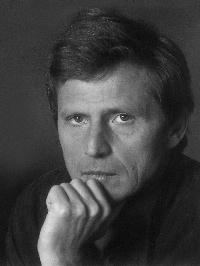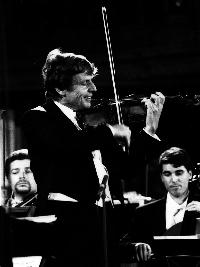




















o
|


 Featured on:
Featured on:
Viotti/Mozart cdc 010
|
The
profile of Uto Ughi can be outlined in a few words - one of the
greatest violinists of our times, the undisputed heir to the Italian
tradition of violin-playing with all its world-wide influence. To
go to one of his concerts is always a moving event: the audience
is deeply involved and moved to enthusiasm and Ughi's charisma is
such that every performance is of a never-to-be-repeated character.
His extraordinary talent was evident from early childhood and he
was an infant prodigy. A pupil of George Enescu, who had previously
taught Yehudi Manuhin, Ughi performed for the first time in public
with Bach's "Ciaccona" (from "Partita n. 2") and some of Paganini's
"Capricci" - he |
was only seven years old at the time.
 Ughi rapidly achieved
international fame and since that time his career has never looked back.
His great skill has brought him to play in the most important capitals
of Eurospe. He has performed throughout the whole world at the principal
musical festivals and played with the most important symphonic orchestras
now in existence (the Concertgebouw of Amsterdam, the Boston Symphony
Orchestra, the Philadelphia Orchestra, the New York Philarmonic, and the
Washington Symphony Orchestra, to name only the most obvious) and under
the most acclaimed of the world's conductors - Sargent, Celibidache, Sir
Colin Davis, Leitner, Pretre, Rostropovic, Sinopoli, Sawallisch, Mehta,
Barbirolli, Cluytens, Chung, Masur and Ceccato. Ughi rapidly achieved
international fame and since that time his career has never looked back.
His great skill has brought him to play in the most important capitals
of Eurospe. He has performed throughout the whole world at the principal
musical festivals and played with the most important symphonic orchestras
now in existence (the Concertgebouw of Amsterdam, the Boston Symphony
Orchestra, the Philadelphia Orchestra, the New York Philarmonic, and the
Washington Symphony Orchestra, to name only the most obvious) and under
the most acclaimed of the world's conductors - Sargent, Celibidache, Sir
Colin Davis, Leitner, Pretre, Rostropovic, Sinopoli, Sawallisch, Mehta,
Barbirolli, Cluytens, Chung, Masur and Ceccato.
 Ughi's recording
activity has been equally intense. He produced Beethoven's and Brahms's
"Concerti" with Ughi's recording
activity has been equally intense. He produced Beethoven's and Brahms's
"Concerti" with Sawallisch, Tschaikovsky's "Concerto" with Sanderling, the "Concerti"
of Mendelssohn and of Bruch with Pretre; some of Beethoven's sonatas,
all of Mozart's "Concerti", Vivaldi's
"Four Seasons", Dvorak's "Concerto" with the London Philharmonic Orchestra;
Bach's "Sonate e Partite" for solo violin, and - as director and soloist
- Paganini's three "Concerti".
Sawallisch, Tschaikovsky's "Concerto" with Sanderling, the "Concerti"
of Mendelssohn and of Bruch with Pretre; some of Beethoven's sonatas,
all of Mozart's "Concerti", Vivaldi's
"Four Seasons", Dvorak's "Concerto" with the London Philharmonic Orchestra;
Bach's "Sonate e Partite" for solo violin, and - as director and soloist
- Paganini's three "Concerti".
 But Uto Ughi does
not confine his interests to music alone. He is active in the public life
of his country, sensitive to the defence and diffusion of moral and ethical
principles, and active in the safeguarding of the nation's artistic inheritance.
Over recent years he has dedicated a part of his artistic activity, in
co-operation with a number of comunes and national associations, to the
promotion of initiatives designed to draw people - and especially young
people - closer to the world of classical music. In line with this public
commitment, last year he put on a concert in memory of Madre Teresa of
Calcutta which was organised by the Centro di Promozione Artistica and
broadcast by RAIUNO, the first Italian state TV network. But Uto Ughi does
not confine his interests to music alone. He is active in the public life
of his country, sensitive to the defence and diffusion of moral and ethical
principles, and active in the safeguarding of the nation's artistic inheritance.
Over recent years he has dedicated a part of his artistic activity, in
co-operation with a number of comunes and national associations, to the
promotion of initiatives designed to draw people - and especially young
people - closer to the world of classical music. In line with this public
commitment, last year he put on a concert in memory of Madre Teresa of
Calcutta which was organised by the Centro di Promozione Artistica and
broadcast by RAIUNO, the first Italian state TV network.
 Uto Ughi plays
a very valuable violin - a Guarneri del Ges — of 1744 known as "Cariplo".
It has a warm tonality and a dark timbre, and is considered one of the
best Guarneris still in existence. He also sometimes plays a Stradivarius
of 1701 called "Kreutzer" after the great violinist to whom Beethoven
dedicated his famous sonata. Uto Ughi plays
a very valuable violin - a Guarneri del Ges — of 1744 known as "Cariplo".
It has a warm tonality and a dark timbre, and is considered one of the
best Guarneris still in existence. He also sometimes plays a Stradivarius
of 1701 called "Kreutzer" after the great violinist to whom Beethoven
dedicated his famous sonata.

© P&P - Promozione e Produzione, Rome.
|


 Sawallisch, Tschaikovsky's "Concerto" with Sanderling, the "Concerti"
of Mendelssohn and of Bruch with Pretre; some of Beethoven's sonatas,
all of Mozart's "Concerti", Vivaldi's
"Four Seasons", Dvorak's "Concerto" with the London Philharmonic Orchestra;
Bach's "Sonate e Partite" for solo violin, and - as director and soloist
- Paganini's three "Concerti".
Sawallisch, Tschaikovsky's "Concerto" with Sanderling, the "Concerti"
of Mendelssohn and of Bruch with Pretre; some of Beethoven's sonatas,
all of Mozart's "Concerti", Vivaldi's
"Four Seasons", Dvorak's "Concerto" with the London Philharmonic Orchestra;
Bach's "Sonate e Partite" for solo violin, and - as director and soloist
- Paganini's three "Concerti".